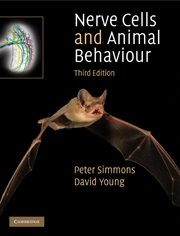Book contents
- Frontmatter
- Contents
- Preface
- 1 Organisation of animal behaviour and of brains: feeding in star-nosed moles and courtship in fruit flies
- 2 Signals in nerve cells: reflexes in mammals and insects
- 3 Neuronal mechanisms for releasing behaviour: predator and prey – toad and cockroach
- 4 Neuronal pathways for behaviour: startle behaviours and giant neurons in crayfish and fish
- 5 Eyes and vision: sensory filtering and course control in insects
- 6 Sensory maps: hunting by owls and bats
- 7 Programmes for movement: how nervous systems generate and control rhythmic movements
- 8 Changes in nerve cells and behaviour: learning in bees and rats; swarming in locusts
- 9 Nerve cells and animal signalling: songs of crickets, electric fish and birds
- References
- Index
- References
References
Published online by Cambridge University Press: 05 August 2012
- Frontmatter
- Contents
- Preface
- 1 Organisation of animal behaviour and of brains: feeding in star-nosed moles and courtship in fruit flies
- 2 Signals in nerve cells: reflexes in mammals and insects
- 3 Neuronal mechanisms for releasing behaviour: predator and prey – toad and cockroach
- 4 Neuronal pathways for behaviour: startle behaviours and giant neurons in crayfish and fish
- 5 Eyes and vision: sensory filtering and course control in insects
- 6 Sensory maps: hunting by owls and bats
- 7 Programmes for movement: how nervous systems generate and control rhythmic movements
- 8 Changes in nerve cells and behaviour: learning in bees and rats; swarming in locusts
- 9 Nerve cells and animal signalling: songs of crickets, electric fish and birds
- References
- Index
- References
- Type
- Chapter
- Information
- Nerve Cells and Animal Behaviour , pp. 262 - 279Publisher: Cambridge University PressPrint publication year: 2010



